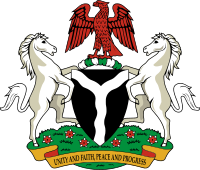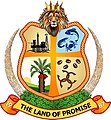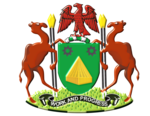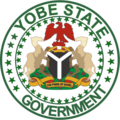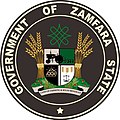
The coat of arms of South Africa is the main heraldic insignia of South Africa. The present coat of arms was introduced on Freedom Day, 27 April 2000, and was designed by Iaan Bekker. It replaced the earlier national arms, which had been in use since 1910. The motto is written in the extinct |Xam, member of the Khoisan languages, and translates literally to "diverse people unite". The previous motto, in Latin, was Ex Unitate Vires, translated as "From unity, strength".

The coat of arms of Saskatchewan, officially known as His Majesty's Arms in right of Saskatchewan, is the heraldic symbol representing the Canadian province of Saskatchewan.

The coat of arms of Nova Scotia is the heraldic symbol representing the Canadian province of Nova Scotia. It is the oldest provincial achievement of arms in Canada, and the oldest British coat of arms in use outside Great Britain. It is blazoned as follows: Argent, a saltire azure charged with an escutcheon of the Royal Arms of Scotland.

The coat of arms of Western Australia is the official coat of arms of the Australian state of Western Australia. It was granted by a royal warrant of Elizabeth II, Queen of Australia dated 17 March 1969.

The coat of arms of the Philippines features the eight-rayed sun of the Philippines with each ray representing the eight provinces which were placed under martial law by Governor-General Ramón Blanco Sr. during the Philippine Revolution, and the three five-pointed stars representing the three major island groups of Luzon, the Visayas, and Mindanao.

The flag of Nigeria was designed by Michael Taiwo Akinkunmi and was officially adopted to represent the nation of Nigeria at midnight on 1 October 1960, the day the country gained independence. The flag was chosen as part of a nationwide open contest held by the government, with Akinkunmi's design being selected as the winner of a field of over three thousand entries. The flag is a vertical bicolour green-white-green design, with the green to represent agriculture and white to represent peace and unity.

The coat of arms of Yukon is the heraldic symbol representing the Canadian territory of Yukon. The arms was commissioned by the federal Department of Indian Affairs and Northern Development and designed by well-known heraldry expert Alan Beddoe in the early 1950s. It was officially approved by Queen Elizabeth II in 1956.

In heraldry, an ordinary is one of the two main types of charges, beside the mobile charges. An ordinary is a simple geometrical figure, bounded by straight lines and running from side to side or top to bottom of the shield. There are also some geometric charges known as subordinaries, which have been given lesser status by some heraldic writers, though most have been in use as long as the traditional ordinaries. Diminutives of ordinaries and some subordinaries are charges of the same shape, though thinner. Most of the ordinaries are theoretically said to occupy one-third of the shield; but this is rarely observed in practice, except when the ordinary is the only charge.

The coat of arms of Toronto is a heraldic symbol used to represent the city Toronto. Designed by Robert Watt, the Chief Herald of Canada at the time, for the City of Toronto after its amalgamation in 1998. The arms were granted by the Canadian Heraldic Authority on 11 January 1999.

The current coat of arms of Zimbabwe was adopted on 21 September 1981, one year and five months after the national flag was adopted. Previously the coat of arms of Zimbabwe was identical to the former coat of arms of Rhodesia.

The coat of arms of Sierra Leone, were developed by the College of Arms and granted in 1960.

Portuguese heraldry encompasses the modern and historic traditions of heraldry in Portugal and the Portuguese Empire. Portuguese heraldry is part of the larger Iberian tradition of heraldry, one of the major schools of heraldic tradition, and grants coats of arms to individuals, cities, Portuguese colonies, and other institutions. Heraldry has been practiced in Portugal at least since the 12th century, however it only became standardized and popularized in the 16th century, during the reign of King Manuel I of Portugal, who created the first heraldic ordinances in the country. Like in other Iberian heraldic traditions, the use of quartering and augmentations of honor is highly representative of Portuguese heraldry, but unlike in any other Iberian traditions, the use of heraldic crests is highly popular.

Fraser Herald of Arms is the title of one of the officers of arms at the Canadian Heraldic Authority in Ottawa. Like the other heralds at the Authority, the name is derived from the Canadian river of the same name. Since the inception of the office, Fraser Herald of Arms has been the principal artist of the Canadian Heraldic Authority. As such, Fraser is responsible for overseeing the artwork created for all grants of arms emanating from the Authority.

In heraldry and heraldic vexillology, a blazon is a formal description of a coat of arms, flag or similar emblem, from which the reader can reconstruct the appropriate image. The verb to blazon means to create such a description. The visual depiction of a coat of arms or flag has traditionally had considerable latitude in design, but a verbal blazon specifies the essentially distinctive elements. A coat of arms or flag is therefore primarily defined not by a picture but rather by the wording of its blazon. Blazon is also the specialized language in which a blazon is written, and, as a verb, the act of writing such a description. Blazonry is the art, craft or practice of creating a blazon. The language employed in blazonry has its own vocabulary, grammar and syntax, which becomes essential for comprehension when blazoning a complex coat of arms.

The coat of arms of Kropyvnytskyi is one of the city's symbols reflecting its past and the controversies of its history.

A pall in heraldry and vexillology is a Y-shaped charge, normally having its arms in the three corners of the shield. An example of a pall placed horizontally (fesswise) is the green portion of the South African national flag.

The coat of arms of Malawi is based on the earlier heraldic arms of Nyasaland. It is supported by a lion and a leopard, above a scroll reading "Unity and Freedom". A rising sun in a black field, like in the lower field in the shield, is also present in the flag of Malawi.
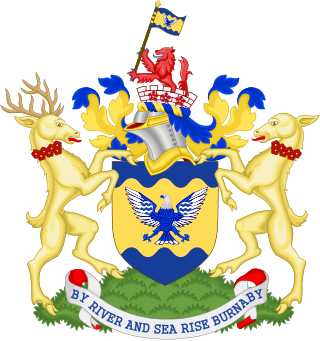
The coat of arms of Burnaby was granted originally to the Corporation of the District of Burnaby by the Canadian Heraldic Authority in 1991, and then reconfirmed for the city of Burnaby in 2005 as the corporation's successor. The grant included the full coat of arms as well as a flag and a badge, both derived from the arms.
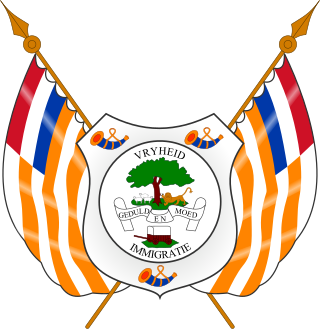
The coat of arms of the Orange Free State was the official heraldic symbol of the Orange Free State as a republic from 1857 to 1902, and later, from 1937 to 1994, as a province of South Africa. It is now obsolete.
Nigerian heraldry is the system of heraldry that exists in Nigeria. It dates to the country's pre-colonial period, and due to an absence of a central heraldic authority, it is currently largely unregulated.
